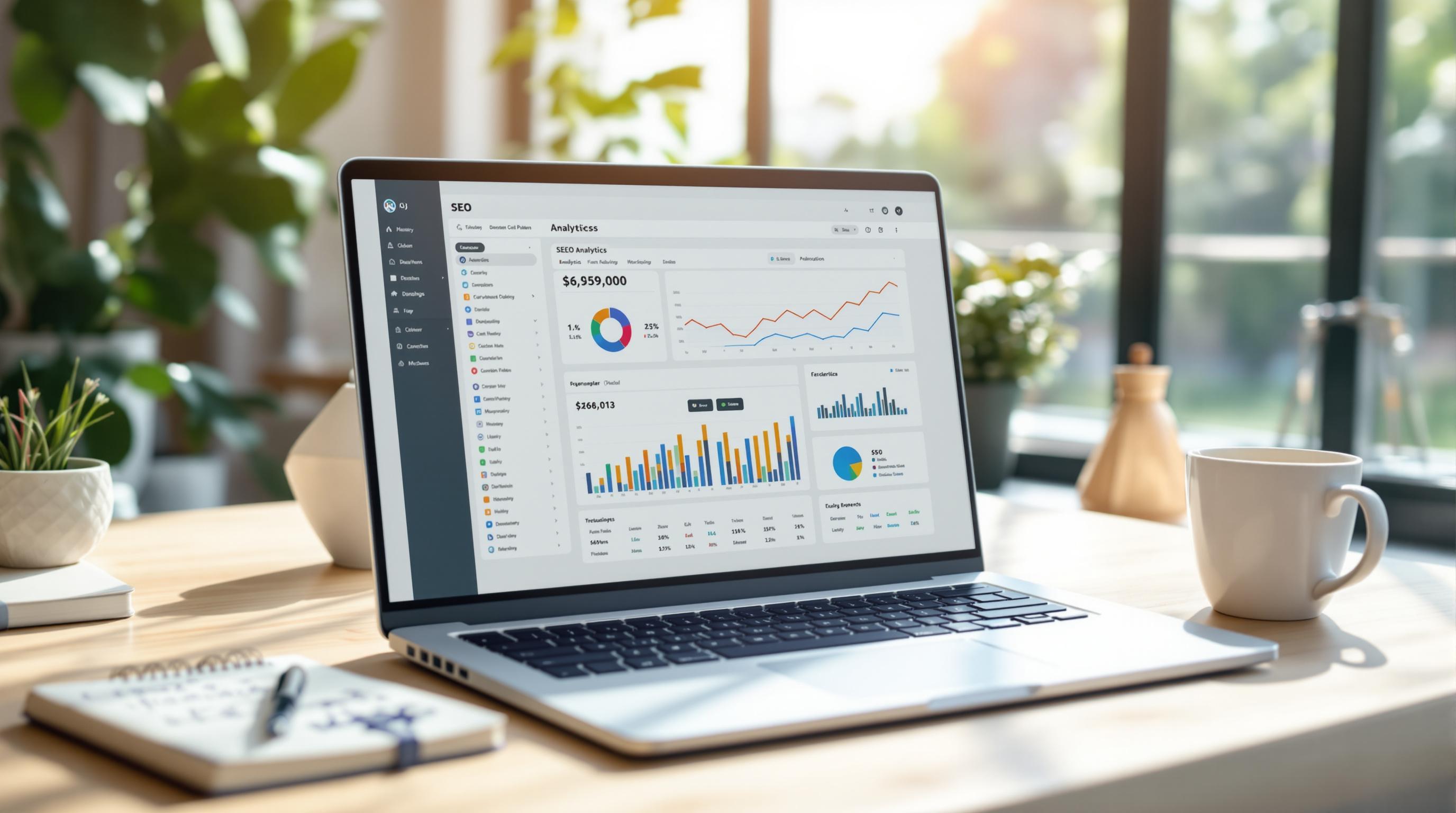SEO delivers better ROI than paid ads in 2025, especially for long-term growth. Here's why:
- SEO ROI: Averages 550%–748%, compared to paid ads at 200%.
- Cost-Effectiveness: SEO costs drop over time, while paid ads require constant spending.
- Conversion Rates: SEO converts at 14.6%, outperforming paid ads at 10%.
- Traffic Sustainability: SEO builds ongoing traffic; paid ads stop when the budget ends.
- Revenue Impact: For every $100K spent, SEO generates $51,724 in revenue, while paid ads bring $23,275.
Key takeaway: SEO is a better choice for businesses focused on sustainable growth, while paid ads are ideal for quick results or short-term campaigns.
Quick Comparison
| Metric | SEO | Paid Ads |
|---|---|---|
| Average ROI | 550%–748% | 200% |
| Revenue per $100K Spent | $51,724 | $23,275 |
| Conversion Rate | 14.6% | 10% |
| Traffic Duration | Long-lasting | Ends with budget |
| Cost per Paying Customer (Trades) | $126.09 | $552.93 |
| Best Timeline | 6+ months | Immediate results |
Both strategies have their place, but for businesses aiming to maximize ROI over time, SEO is the clear winner.
SEO vs. Paid Ads: Which is Better in 2025?
ROI Comparison: SEO vs Paid Ads
When it comes to return on investment (ROI), SEO consistently outshines paid ads in the long run. Let’s break down the numbers to see why.
ROI Metrics Analysis for SEO and Paid Ads
SEO's ability to generate lasting value is reflected in its ROI metrics. Studies reveal that SEO delivers an average ROI of 550%, with some cases reaching as high as 748% - that’s $7.48 earned for every dollar spent. In contrast, PPC campaigns typically generate an ROI of around 200%.
Here’s an example: A business allocating $100,000 annually to digital marketing could see $51,724 in revenue from SEO efforts, compared to just $23,275 from PPC campaigns. Simply put, SEO can more than double the returns.
For industries like trades, the contrast is even starker. SEO offers nearly 5x better return on ad spend, with a cost per paying customer of $126.09, compared to $552.93 for paid ads. Other sectors also see impressive results from SEO investments:
- Real estate enjoys an ROI of 1,389%
- E-commerce reaches around 875%
- Healthcare achieves about 510%
- Professional services hover around 620%.
While paid ads provide quick traffic and measurable short-term results, SEO's cumulative benefits make it a stronger choice for long-term gains. The table below highlights the key differences.
Key ROI Metrics Comparison Table
| Metric | SEO | Paid Ads |
|---|---|---|
| Average ROI | 550% – 748% | 200% |
| Revenue per $100K Spent | $51,724 | $23,275 |
| Conversion Rate | 14.6% | 10% |
| Cost per Paying Customer (Trades) | $126.09 | $552.93 |
| Return on Ad Spend (Trades) | Nearly 5x higher | Baseline |
| Time to Results | Gradual (builds over time) | Immediate |
| Sustainability | Builds ongoing value | Stops when budget ends |
Research further underscores this gap: 70% of marketers report that SEO drives more sales than PPC. On average, SEO delivers an 8x return, while PPC caps at 4x. This difference underscores the long-term effectiveness of SEO as a revenue-generating strategy.
Factors That Affect ROI
ROI isn’t just about the numbers - it’s shaped by several key elements that can influence your outcomes. By understanding these factors, you can make smarter decisions and stretch your marketing dollars further.
Traffic Generation and Visibility
How a strategy drives traffic plays a big role in its ROI potential. Organic search, powered by SEO, tends to bring in steady, long-lasting traffic. Once you’ve created optimized content, it keeps working for you, pulling in visitors long after publication. Paid ads, on the other hand, offer quick exposure but stop delivering the moment you pause your spending.
Conversion Rates and User Trust
Trust is everything when it comes to converting users, and it’s a major reason why organic search often outperforms paid ads. People generally see organic results as more reliable since they’re earned, not bought. This trust translates into higher conversion rates because users feel more confident engaging with organic results compared to paid ones. And when you combine this trust with the traffic advantages of organic search, the ROI difference becomes even clearer.
Cost-Effectiveness and Scalability
The way each strategy handles costs is another critical factor. Think of SEO as an investment that grows over time - like owning property. As your content library and domain authority expand, your costs per visitor drop, making it more affordable to scale. Paid ads, however, require constant funding. Scaling them often means spending more, especially in competitive niches where keyword prices can skyrocket.
These dynamics explain why businesses with tighter budgets often lean toward SEO for its long-term benefits, while those chasing instant results may stick with paid ads despite the ongoing costs. Both strategies have their place, but understanding these factors can help you align your approach with your goals.
sbb-itb-5be333f
Long-Term Value: SEO vs Paid Ads
When planning your marketing budget, it’s crucial to think about long-term results. The difference between SEO and paid ads becomes especially clear when you consider the impact months or even years down the road.
SEO: Built to Last
SEO is all about building momentum. Once your website climbs higher in search rankings, it keeps bringing in traffic without constant effort. This compounding effect means your initial investment continues to pay off over time.
A 2025 study of home service businesses found that SEO delivered a 19.9x return on ad spend, compared to just 4.4x for paid ads. Even more impressive, SEO achieved these results while requiring far less spending - $539,651 versus $2,267,565. A well-optimized post doesn’t just fade away; it builds authority and keeps driving traffic long after it’s published. Over time, as your site earns more trust from search engines, new content ranks faster and higher, creating a self-reinforcing cycle of growth.
Paid ads, on the other hand, don’t offer the same staying power. They require consistent funding to remain effective.
Paid Ads: Here Today, Gone Tomorrow
Paid advertising operates on a much shorter timeline. As soon as you stop funding your campaigns, your visibility vanishes. While paid ads can provide instant results, they don’t offer lasting value once the budget dries up.
This creates constant pressure to keep spending. Even the most successful ad campaigns won’t help your business tomorrow if the funding stops today. Plus, scaling paid ads means spending more. As competition increases, keyword costs rise, making it more expensive to maintain visibility. Unlike SEO - where growing authority can reduce the cost per visitor - paid ads typically become pricier over time, especially in competitive markets.
These differences highlight the contrast between short-term and long-term benefits, as shown in the table below.
Long-Term vs Short-Term Benefits Comparison Table
| Benefit Type | SEO (Organic) | Paid Ads (PPC) |
|---|---|---|
| Traffic Duration | Ongoing, compounds over time | Stops when budget ends |
| Cost Structure | Upfront investment, low maintenance | Continuous spend per click |
| Revenue Growth per $100K Investment | $51,724 | $23,276 |
| User Trust Factor | High (organic credibility) | Lower (ad fatigue) |
| Scalability | Grows with authority | Limited by budget |
| Best Timeline | 6+ months for full impact | Immediate results |
According to 2025 data, organic search accounts for 26.7% of total website visits, slightly ahead of paid search at 23%. The real edge lies in sustainability.
For businesses working with tighter marketing budgets, SEO’s long-term value is especially appealing. While paid ads demand constant funding to maintain visibility, a well-planned SEO strategy can keep delivering results, even if marketing spend is reduced. This makes SEO a reliable option during economic downturns or seasonal slumps.
If you’re looking to maximize your marketing dollars, SEO’s lasting impact can be a game-changer. To get started, explore the Top SEO Marketing Directory for tools and services that can help you achieve sustainable growth.
Which Strategy Delivers Better ROI in 2025?
If you're looking at the numbers, SEO is the clear winner for return on investment (ROI) in 2025. On average, SEO delivers a staggering ROI of 550%, while PPC lags behind at about 200%. Even when it comes to conversions, organic search has a conversion rate of 14.6%, compared to PPC's 10%.
That said, the "better" strategy really depends on what your business needs at any given time. SEO is a powerhouse for long-term growth and building a solid brand presence. On the other hand, paid ads are perfect for quick wins and campaigns that need results fast. For instance, in the trades industry, SEO returned $19.90 for every dollar spent, while paid ads brought in $4.40. Clearly, SEO has the upper hand in ROI, but the timing and goals of your business will dictate which approach makes more sense.
Choosing the Right Strategy
The truth is, it's not about picking one strategy over the other - it’s about knowing when to use each one. A majority of B2B marketers (57%) consider SEO the most effective digital marketing channel, and 70% say SEO drives more sales than PPC. For companies with a long-term vision, SEO should be a priority. After all, SEO leads boast a close rate of 14.6%, far outpacing the 1.7% close rate for outbound efforts.
However, paid ads shine when speed is essential, like when you're launching a new product or breaking into a fresh market. Many businesses find success with a hybrid approach, often following a 70/30 rule: 70% of the budget goes toward the primary goal (growth or stability), while the remaining 30% supports the secondary channel. This way, you can capitalize on immediate opportunities with PPC while building lasting assets through SEO. Plus, using paid ads to test keywords before committing to long-term SEO strategies can help you avoid wasting resources and focus on what works.
Using the Top SEO Marketing Directory

Given SEO's impressive long-term ROI, having the right tools and expertise is crucial. The Top SEO Marketing Directory is a go-to resource in 2025, offering a curated list of the best SEO solutions available. Whether you need help with technical SEO, content optimization, keyword research, or link building, this directory connects you with trusted tools and agencies.
The directory covers everything from basic SEO audit tools to enterprise-level platforms. It also includes specialized services for areas like local SEO, e-commerce optimization, and mobile SEO - key elements for staying competitive and maximizing ROI.
With SEO delivering such strong returns, having access to expert guidance and analytics tools can make all the difference. Whether you’re just starting out or refining your current strategy, the directory ensures you’re working with proven, results-driven solutions to accelerate your success.
FAQs
How can businesses decide the right mix of SEO and paid ads to achieve their goals?
To strike the right balance between SEO and paid ads, businesses need to start by considering their goals, budget, and timeline. SEO works best as a long-term strategy. It helps build steady growth over time and often delivers a strong return on investment (ROI), especially for businesses aiming to improve organic visibility and keep costs manageable. On the other hand, paid ads are ideal for quick wins - whether it’s testing a new idea, launching a product, or driving immediate traffic.
A smart strategy combines both approaches. Use paid ads for short-term campaigns or when you need fast results, while continuing to invest in SEO to secure consistent, long-term growth. Keep an eye on performance metrics and adjust your strategy to align with your evolving goals and market conditions. This way, you can meet immediate needs while setting yourself up for future success.
What should businesses consider when comparing the long-term ROI of SEO to the immediate impact of paid ads?
When weighing the long-term returns of SEO against the immediate impact of paid ads, businesses need to consider factors like cost, longevity, and required investment.
SEO is a long-game strategy. Once your site is optimized, it can consistently drive organic traffic without the need for constant spending. While the upfront costs for creating and optimizing content might feel steep, the ongoing maintenance typically becomes more affordable, making SEO a smart choice for long-term savings. Plus, it enhances credibility and authority, which can reduce customer acquisition costs over time.
Paid ads, on the other hand, are perfect for quick wins. They offer instant visibility and can help you achieve short-term goals or drive immediate results. But there’s a catch: as soon as you stop funding the ads, the traffic disappears. Over time, the expense of maintaining paid campaigns can surpass the costs of SEO, particularly for businesses focused on sustained growth.
The best approach? It depends on your goals, budget, and timeline. Often, combining both strategies - leveraging the instant boost of paid ads while building the lasting benefits of SEO - delivers the most effective results.
How can businesses track and measure the ROI of their SEO efforts over time?
To figure out the ROI of your SEO strategy, you'll need to compare the revenue generated from organic traffic with the costs associated with your SEO efforts. Keep an eye on these important metrics:
- Organic traffic: Tracks how many visitors land on your site via search engines.
- Keyword rankings: Shows how well your target keywords rank in search engine results.
- Conversion rate: Measures the percentage of visitors who complete desired actions, like making a purchase or signing up.
- Click-through rate (CTR): Reflects the percentage of users who click on your site from search engine results pages.
To calculate ROI, use this formula:
(Revenue from SEO - Cost of SEO) ÷ Cost of SEO × 100
It’s worth noting that SEO often takes time to deliver results, but many businesses see positive ROI within 6 to 12 months. By regularly reviewing these metrics, you can ensure your SEO strategy remains effective and continues to provide measurable results.


